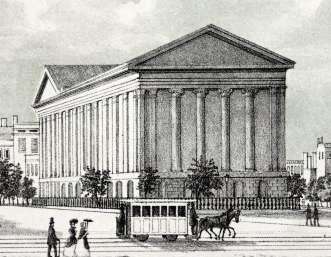Astor Opera House
The Astor Opera House, also known as the Astor Place Opera House and later the Astor Place Theatre,[1] was an opera house in Manhattan, New York City, located on Lafayette Street between Astor Place and East 8th Street. Designed by Isaiah Rogers, the theater was conceived by impresario Edward Fry, the brother of composer William Henry Fry, who managed the opera house during its entire history.[2][3]


Opera House
Fry engaged the Sanquerico and Patti Opera Company under the management of John Sefton to perform the first season of opera at the house. The opera house opened on November 22, 1847 with a performance of Giuseppe Verdi's Ernani with Adelino Vietti in the title role.[4] Sefton and his company were not re-engaged by Fry, and the opera management of the house went to Cesare Lietti for the second season. During his tenure the opera house presented the United States premiere of Verdi's Nabucco on April 4, 1848.[5]
Lietti was also replaced after one season, and the Astor's third and longest lasting opera manager, Max Maretzek, was hired for the third season, which commenced in November 1848.[6] The following year Maretzek founded his own opera company, the Max Maretzek Italian Opera Company, with whom he continued to stage operas at the Astor Opera House through 1852.[7][8] Under Maretzek the opera house saw the New York premiere of Donizetti's Anna Bolena on January 7, 1850 with soprano Apollonia Bertucca (later Maretzek's wife) as the title heroine.[9]
The theatre was built with the intention of attracting only the "best" patrons, the "uppertens" of New York society, who were increasingly turning out to see European singers who appeared at local venues such as Niblo's Garden. It was expected that an opera house would be:
a substitute for a general drawing room – a refined attraction which the ill-mannered would not be likely to frequent, and around which the higher classes might gather, for the easier interchange of courtesies, and for that closer view which aides the candidacy of acquaintance.[10]
In pursuit of this agenda, the theatre was created with the comfort of the upper classes in mind: benches, the normal seating in theatres at the time, were replaced by upholstered seats, available only by subscription, as were the two tiers of boxes. On the other hand, 500 general admission patrons were relegated to the benches of a "cockloft" reachable only by a narrow stairway, and otherwise isolated from the gentry below,[3] and the theatre enforced a dress code which required "freshly shaven faces, evening dress, and kid gloves."[11]
Limiting the attendance of the lower classes was partly intended to avoid the problems of rowdyism which plagued other theaters in the entertainment district at the time, especially in the theatres on the Bowery. Nevertheless, it was the deadly Astor Place riot in 1849 which caused the theatre to close permanently – provoked by competing performances of Macbeth by English actor William Charles Macready at the Opera House (which was operating under the name "Astor Place Theatre", not being able to sustain itself on a full season of opera) and American Edwin Forrest at the nearby Broadway Theatre.
Clinton Hall
After the riot, the theater was unable to overcome the reputation of being the "Massacre Opera House" at "DisAster Place."[12] By May 1853, the interior had been dismantled and the furnishings sold off, with the shell of the building sold for $140,000[13] to the New York Mercantile Library, which renamed the building "Clinton Hall".[14]
In 1890, in need of additional space, the library tore down the opera house building and replaced it with an 11-story building, also called Clinton Hall, which still stands on the site.[15]
References
Notes
- Not the same as the current Astor Place Theatre
- Newman, Nancy (2010). Good Music for a Free People: The Germania Musical Society in Nineteenth-century America. University Rochester Press. p. 40.
- Burrows & Wallace, p.724
- Ireland, p.515
- Martin, George Whitney (2011). Verdi in America: Oberto Through Rigoletto. University Rochester Press. p. 17.
- Ireland, pp.515-543
- Schonberg, Harold C. (November 23, 1969). "Even the Prima Donna Blushed'" (PDF). The New York Times. p. D19.
- Ogasapian, John & Orr, N. Lee (2007). Music of the Gilded Age. Greenwood Publishing Group. p. 35.
- Lawrence, Vera Brodsky (1995). Strong on Music: The New York Music Scene in the Days of George Templeton. University of Chicago Press. p. 3.
- Nathaniel Parker Willis, quoted in Burrows & Wallace, p.724
- Burrows & Wallace, p.760
- Burrows & Wallace, p.765
- "The Mercantile Library" The New York Times (June 1, 1854)
- "Exclusiveness" The New York Times (May 27, 1853)
- White, Norval & Willensky, p.162
Bibliography
- Burrows, Edwin G. & Wallace, Mike (1999). Gotham: A History of New York City to 1898. New York: Oxford University Press. ISBN 0-195-11634-8.
- Ireland, Joseph Norton (1867). Records of the New York Stage: from 1750 to 1860. 2. T. H. Morrell.
- White, Norval & Willensky, Elliot (2000). AIA Guide to New York City (4th ed.). New York: Three Rivers Press. ISBN 978-0-8129-3107-5.
Further reading
- Hassard, Jno. [John] R. G. (February 1871). "The New York Mercantile Library", Scribner’s Monthly Vol. 1 No. 4. New York: Scribner & Co., pp. 353–67
External links
